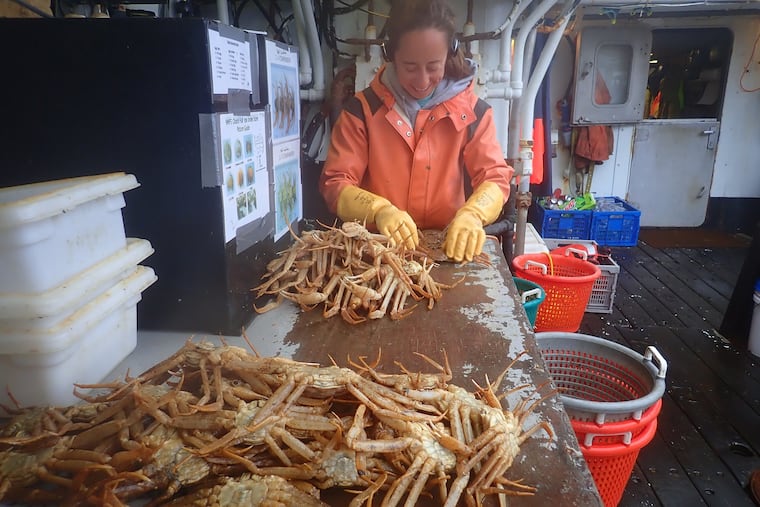Alaska’s snow crab season is canceled. What does that mean for seafood in Philly? We asked a wholesaler.
We chat with Small World Seafood’s owner, Robert Amar, about Alaska’s snow crab shortage and global warming’s impacts on seafood access in Philadelphia.

Alaska’s snow crab season is canceled for the first time. In announcing the news last week, the state’s Board of Fisheries and the North Pacific Fishery Management Council cited a massive population decline prompted by factors including overfishing and global warming.
Still, it doesn’t mean your crab leg dinner is a complete thing of the past.
“Alaska’s not the only place to get snow crabs from,” said Robert Amar, the owner of Philadelphia’s Small World Seafood — a direct-to-consumer seafood wholesaler in Callowhill. “Overall, the stock available to people has diminished. You have to look at it like oil. It’s globally sourced out, but a little supply shortage can cause prices to go up. This is only one part of a much bigger resource.”
Amar said other factors, including inflation and unease about the economy, have driven snow crabs’ price and availability over the years.
“Snow crab and king crab legs exploded last year — they doubled in price. Supermarkets drove that rise in price because people were going to the supermarkets, not restaurants, during the pandemic,” he said. “Supermarkets realized people were willing to pay more than they would in the past.”
But this year, Amar says, things reversed.
“Snow crab came back down to pre-COVID pricing. People are buying down and not splurging as much,” he said.
The market price of snow crab legs has plummeted this year, reports show. Undercurrent News — a news outlet focused on seafood business news and data — noted a drop of over 30% in snow crab wholesale prices.
Amar says that as inflation hits consumers, the demand for high-ticket grocery items, like crab legs, is generally lower, which in turn means less of a need to fish right now.
What happened to the snow crabs in Alaska?
The Alaska Department of Fish and Game said the state’s snow crab population dropped from about 8 billion in 2018 to 1 billion in 2021. According to CNN, officials said that overfishing was a large factor in canceling this year’s snow crab season and that fishing was outpacing the rate of natural replacement.
“It’s a scary number,” Mark Stichert, Alaska’s Fish and Game Department’s groundfish and shellfish fisheries management coordinator, said.
But scientists say overfishing is just one piece contributing to the crab population’s decline in Alaska.
As noted by Bloomberg, scientists have warned that the failure to reduce carbon emissions could lead to the extinction of most marine life as the climate continues to warm. The Bering Sea, which houses an abundant Alaskan snow crab population, has seen warming temperatures, contributing to lower sea-ice cover levels, according to Michael Litzow, the Kodiak lab director for NOAA Fisheries. Litzow says snow crabs, which are cold-water creatures, are sensitive to the loss of ice and warming temperatures.
In the Arctic, temperatures have warmed about four times faster than the rest of the world, scientists say.
What does Alaska’s crab shortage mean for Philadelphia?
Amar says that Alaska is not the only place to get crab meat, or even snow crabs, and that — for now — crab is sticking around.
In Philadelphia, crab remains the star of the menu at restaurants that include Cajun Heroes Seafood & Po’boy, Amazing Crab House, and Crab Du Jour Pennsylvania.
Popular crab meat in the U.S.
Here’s an overview of some of the most popular types of crab meat and where they’re from:
Dungeness crabs live in coastal waters from Alaska to Mexico. They have sweet and succulent meat.
King crabs are large and host bright, white meat with red edges. These are popular in seafood restaurants around the world.
Snow crabs are found in the northern Pacific and Atlantic Oceans in deep, cold waters. They are also called spider crabs because of their spiny legs and are considered relatively affordable compared with other crabs.
Stone crabs are mainly harvested in Florida and are lauded for their large size and sweet flavor. Only the claws are eaten, meaning fishers will pull off a singular claw and then return the crab into the ocean, where their claw will regenerate.
Still, Amar cautioned, consumers and food purveyors alike should be paying attention.
“This is an environmental issue. With waters warming up, that’s what we should be thinking about,” he said.
He added, “maybe on the surface, someone is worrying — ‘I’m not gonna get my lobster,’ but there’s also the question of ‘What’s going on out there on the waters?’”
Last year, Small World Seafood paused scallop and crab sales when there were shortages. Amar wanted to let the market “settle.”
He compared it to tomato season. “In August and September, the tomato quality is higher, the quantity is higher, and the prices are lower. When the price goes down, supply is up and quality tends to be up, too,” he said. “For sustainability, it’s important to be mindful.”